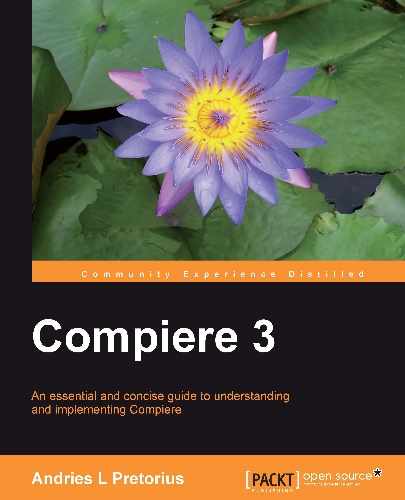The Compiere menu launches the transactional aspects of the system and we will describe the different components as follows:
Depending on your login credentials and role access, you will be presented with the main menu in Compiere. This menu lists your roles and actions that you may perform.
The Swing Menu (Community and Standard Editions) is illustrated as follows:

The Web User Interface (Professional and Enterprise Editions) is as follows:

- Toolbar and Menu Shortcuts: These provide available predefined shortcuts, commands, and preferences.
- Menu Tab: These are available context menus or functions, such as performance dashboards, menu, workflow activities
- Shortcuts and Favorites: Shortcuts are quick launch options, and are added to the shortcut area by right-clicking on the select menu item.
- Menu items access your work areas, including windows, process, reports, views, and Dashboards.
- Menu Search: This is where the user can search for menu items.
Windows are used for data capture and processing, and have a consistent look and feel throughout the application. The menu toolbar and icons are also located in standard positions and have consistent functionality based on the context of the contents of the window.
The Swing user interface window (Community and Standard Edition) is as shown in the following screenshot:

The web user interface window (Professional and Enterprise Edition) is as shown in the following screenshot:

- Toolbar: The toolbar list shortcuts to commands and other windows, preferences, and set-up actions.
- Menu icons: The menu icons in Compiere launch commands in context to the contents of the window, for instance create new record, delete record, refresh, lookup, next record, previous record, and close window.
- Header and Tabs: A header is the first main view in a window, whereas tabs are contextualized to the header or preceding tab. For instance, an Order Header will have an Order Lines tab, and Order Lines will have Order Tax lines.
- Fields: Fields capture the contents of a document, may be mandatory and may be editable, depending on context.
- Window References: Creates a context of fields on a window. If pressed, shortens the window.
- Process buttons: These buttons perform actions and processes depending on the context. For instance, on and order you may process a payment type against it or complete a document.
